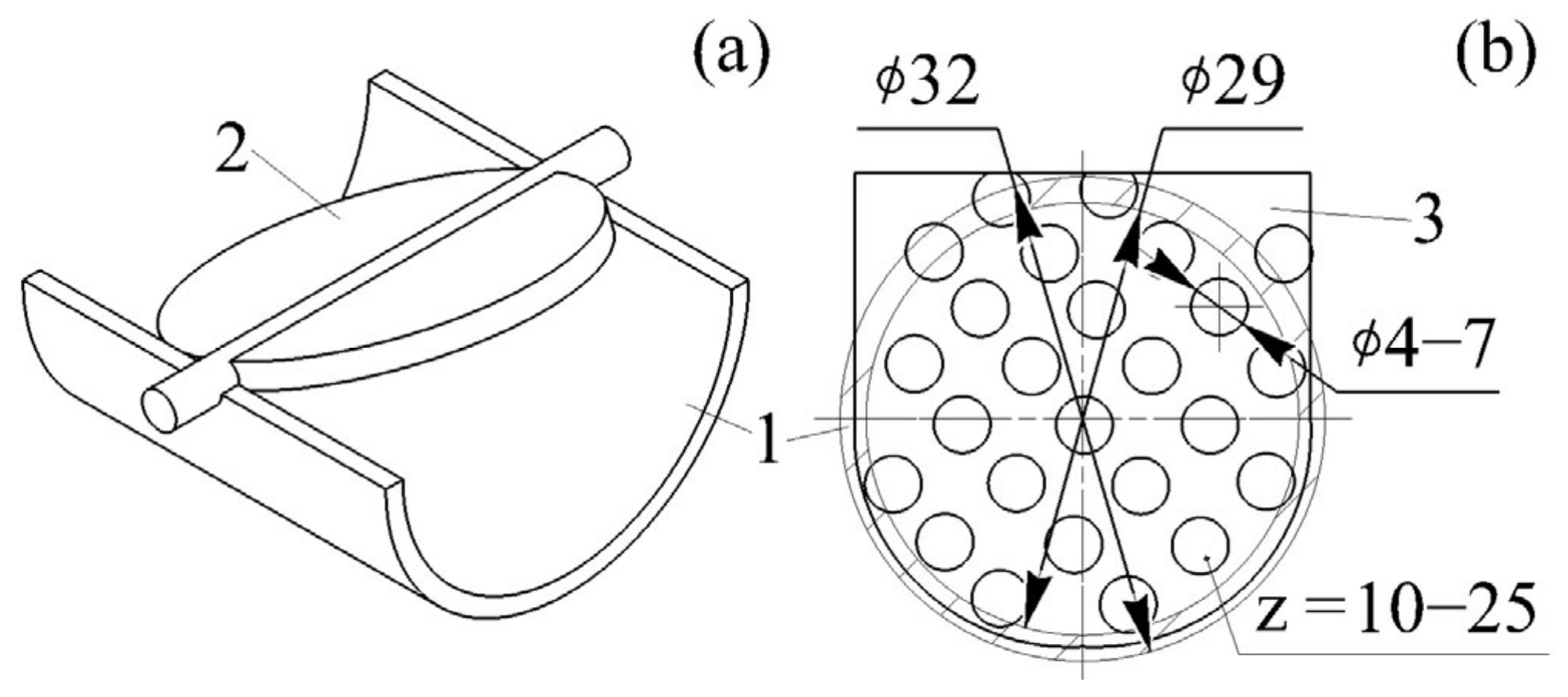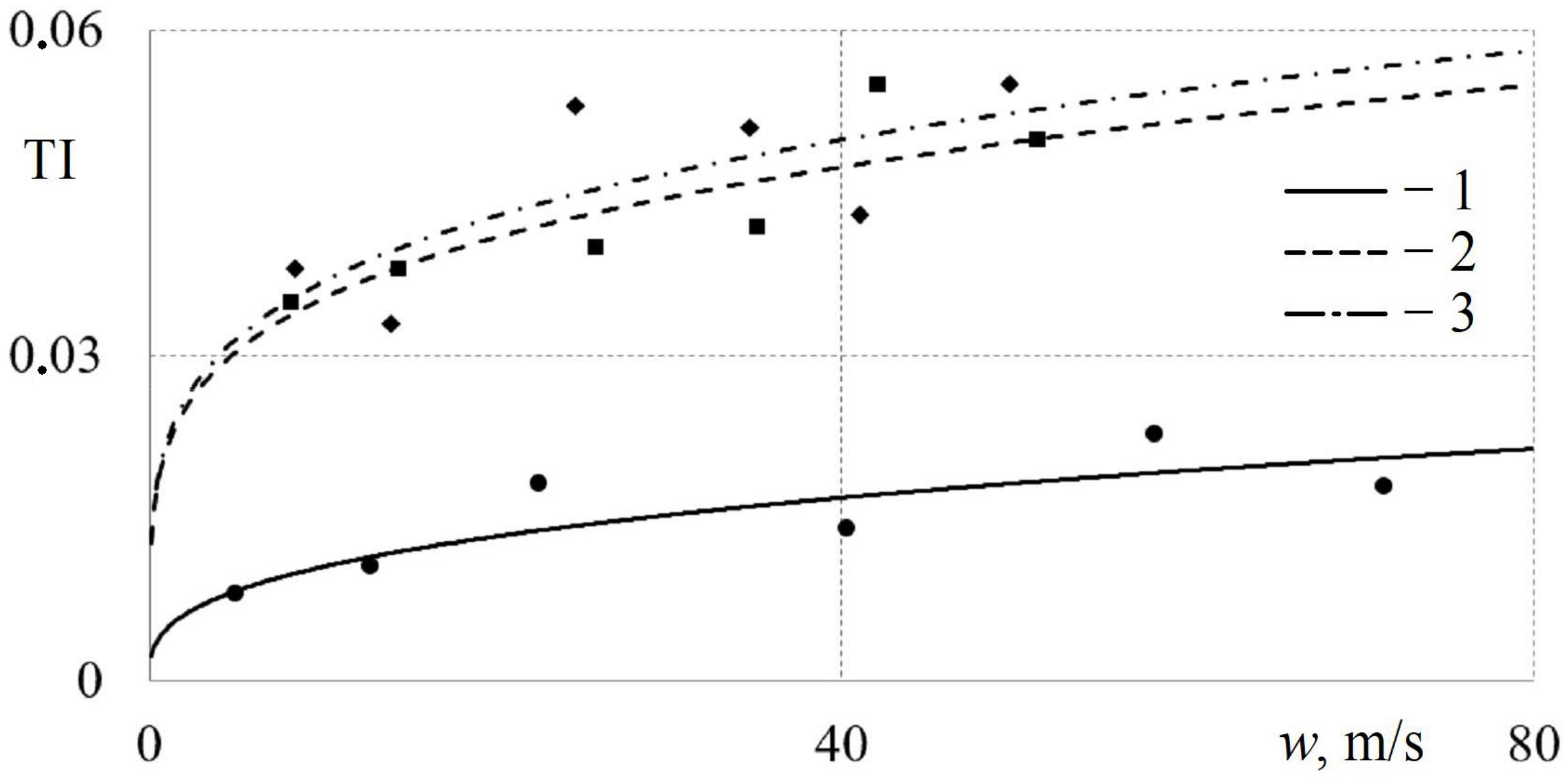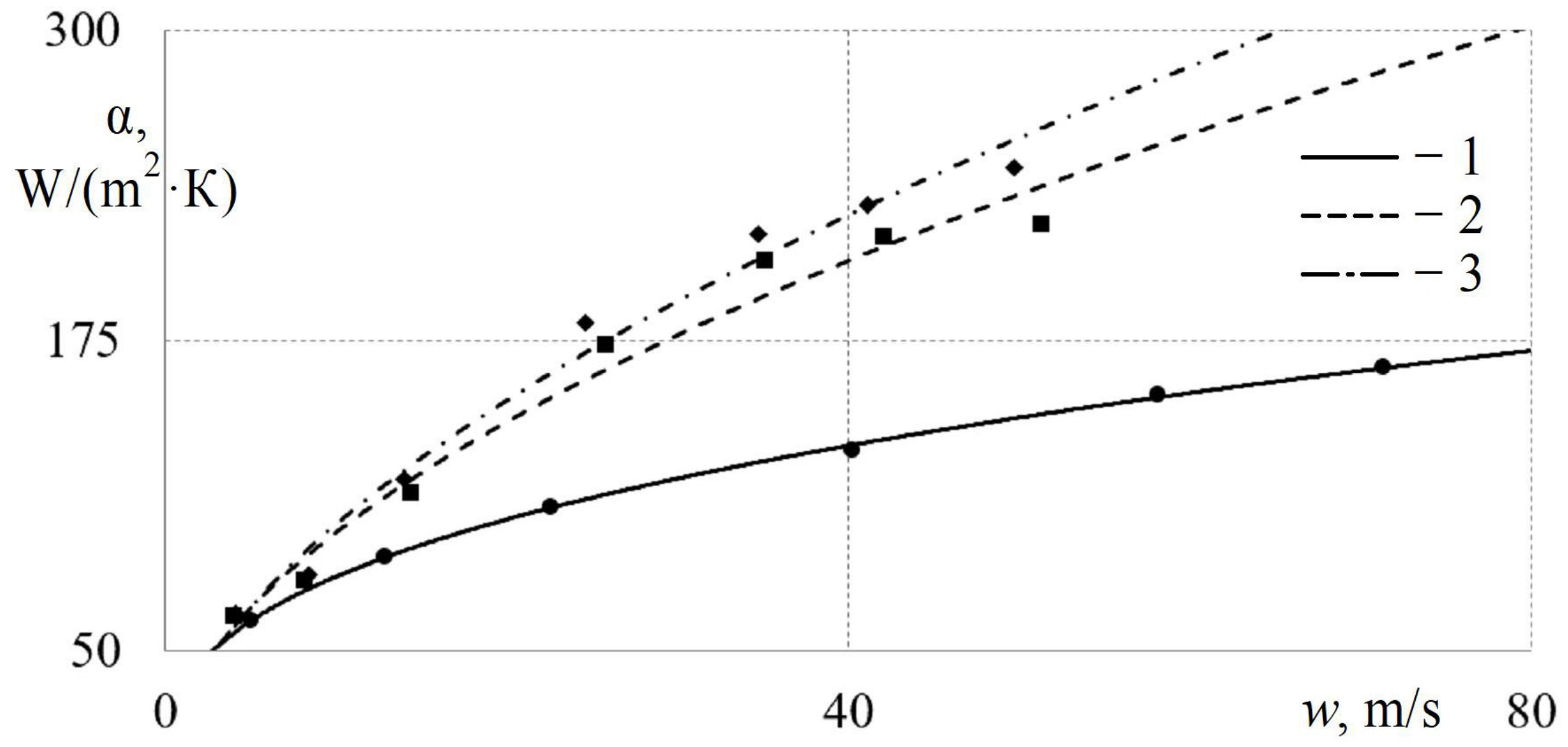The Influence of Gas-Dynamic Non-Stationarity of Air Flow on the Heat Transfer Coefficient in Round and Triangular Straight Pipes with Different Turbulence Intensities
Abstract
:1. Introduction
- -
- To obtain experimental data on instantaneous values of velocity and local HTC of stationary and pulsating air flows with different levels of turbulence in straight pipes with different cross-sectional shapes;
- -
- To evaluate the effect of gas-dynamic non-stationarity on the air flow turbulence intensity in round and triangular straight pipes;
- -
- To establish the effect of gas-dynamic non-stationarity on the air flow heat transfer intensity in round and triangular pipes;
- -
- To identify the effect of air flow pulsation frequency on the TI and the HTC of air flows in pipes with different cross-sectional shapes.
2. Description of the Research Task and Measuring Instruments
3. Experimental Research Results, Analysis and Discussion
- -
- There are pronounced flow pulsations (with corresponding maxima and minima of wx and αx), caused by the blocking of the pipe by the valve for both cases;
- -
- The dependencies wx = f (τ) and αx = f (τ) are practically smooth (with minimal fluctuations) when the flow moves in a round pipe, whereas noticeable fluctuations in the velocity wx and the local HTC αx of the flow are observed when using a TrP; their formation can be associated with secondary vortex flows in the corners of the triangular profile;
- -
- The maximum values of αx in a TrP are visually 10–15% less compared to a round pipe under these experimental conditions.
- -
- There is a significant influence of gas-dynamic non-stationarity on the flow structure and pulsating components of the air flow velocity in a TrP;
- -
- There are opposite tendencies in the change of TI in stationary and pulsating flows in a TrP;
- -
- It is necessary to use optical methods or an entropy generation method [36] for a detailed study of the gas dynamics of pulsating flows (the thermal anemometry method does not provide a complete physical picture of the processes taking place).
- -
- A rise in TI from 0.04 to 0.08 leads to an increase in the HTC α of pulsating flows in a round pipe by 11–16%, which is in good agreement with [39];
- -
- A further rise in the TI of the pulsating flow causes an additional small increase in α within 5–8%;
- -
- Accordingly, there is reason to state that turbulization of the pulsating flow in a round pipe intensifies heat transfer;
- -
- The pulsation frequency f has a weak effect on the heat transfer level of pulsating flows in a round pipe.
- -
- An increase in the TI of the pulsating flow (from 0.04 to 0.08) in a TrP leads to a suppression of heat transfer by up to 24%;
- -
- An increase in the TI of the pulsating flow from 0.04 to 0.15 in a TrP causes a decrease in the HTC to 10.6% (which is within the uncertainty limits of the experiment);
- -
- Accordingly, it can be concluded that turbulization of the pulsating flow in a TrP suppresses heat transfer; the discovered effect requires additional research to clarify the physical mechanism.
4. Conclusions
- A laboratory stand and a measuring system with the required speed for studying the gas dynamics and heat exchange of stationary and pulsating flows in straight pipes with different cross-sectional shapes were created;
- It was found that gas-dynamic non-stationarity (the presence of flow pulsations in comparison with steady motion) led to an increase in the TI by 47–72% in a round straight pipe and by 36–86% in a triangular pipe;
- It was revealed that gas-dynamic non-stationarity (flow pulsations in the range from 4.6 to 15.3 Hz) caused an intensification of heat transfer in a round straight pipe by 26–35.5%;
- It was shown that gas-dynamic non-stationarity (flow pulsations in the range from 3.0 to 15.8 Hz) led to an increase in the HTC in a triangular pipe by 24–36%;
- It was found that increasing TI from 0.04 to 0.12 led to a rise in the HTC of pulsating flows in a round pipe by 11–16%;
- It was revealed that increasing TI (from 0.04 to 0.15) for a pulsating flow in a triangular pipe caused a suppression of heat transfer by 7–24%;
- The obtained results confirm the significant influence of flow pulsations, TI, and the cross-sectional shape of pipelines on the gas-dynamic and heat-exchange characteristics of gas flows in straight pipes.
Author Contributions
Funding
Institutional Review Board Statement
Informed Consent Statement
Data Availability Statement
Acknowledgments
Conflicts of Interest
References
- Yang, K.-S.; Jiang, M.-Y.; Tseng, C.-Y.; Wu, S.-K.; Shyu, J.-C. Experimental investigation on the thermal performance of pulsating heat pipe heat exchangers. Energies 2020, 13, 269. [Google Scholar] [CrossRef]
- Matouq, J.; Al-Waked, R.; Al-Rashdan, M.; Mustafa, D.B.; Nasif, M.S. Computational Fluid Dynamics Analysis of Slip Flow and Heat Transfer at the Entrance Region of a Circular Pipe. Appl. Sci. 2024, 14, 6528. [Google Scholar] [CrossRef]
- Winkler, N. Effect of pressure oscillations on in-cylinder heat transfer—Through large eddy simulation. Int. J. Engine Res. 2015, 16, 705–715. [Google Scholar] [CrossRef]
- Nishandar, S.V.; Pise, A.T.; Bagade, P.M.; Gaikwad, M.U.; Singh, A. Computational modelling and analysis of heat transfer enhancement in straight circular pipe with pulsating flow. Int. J. Interact. Des. Manuf. 2024. [Google Scholar] [CrossRef]
- Hayrullin, A.; Haibullina, A.; Sinyavin, A.; Ilyin, V. Experimental study of the in-line tube bundle thermal performance in pulsating flow. Int. J. Heat Mass Transf. 2024, 232, 125916. [Google Scholar] [CrossRef]
- Haibullina, A.; Khairullin, A.; Balzamov, D.; Ilyin, V.; Bronskaya, V.; Khairullina, L. Local Heat Transfer Dynamics in the In-Line Tube Bundle under Asymmetrical Pulsating Flow. Energies 2022, 15, 5571. [Google Scholar] [CrossRef]
- van Buren, S.; Miranda, A.C.; Polifke, W. Large eddy simulation of enhanced heat transfer in pulsatile turbulent channel flow. Int. J. Heat Mass Transf. 2019, 144, 118585. [Google Scholar] [CrossRef]
- Brahma, I.; Singh, S. Experimental, numerical and deep learning modeling study of heat transfer in turbulent pulsating pipe flow. Appl. Therm. Eng. 2024, 244, 122685. [Google Scholar] [CrossRef]
- Nakamura, H.; Saito, R.; Yamada, S. Delay in response of turbulent heat transfer against acceleration or deceleration of flow in a pipe. Int. J. Heat Fluid Flow 2020, 85, 108661. [Google Scholar] [CrossRef]
- Simonetti, M.; Caillol, C.; Higelin, P.; Dumand, C.; Revol, E. Experimental investigation and 1D analytical approach on convective heat transfers in engine exhaust-type turbulent pulsating flows. Appl. Therm. Eng. 2020, 165, 114548. [Google Scholar] [CrossRef]
- Kato, Y.; Guo, G.; Kamigaki, M.; Fujimoto, K.; Kawaguchi, M.; Nishida, K.; Koutoku, M.; Hongou, H.; Yanagida, H.; Ogata, Y. An Examination of Heat Transfer Dynamics in Pulsating Air Flow within Pipes: Implications for Automotive Exhaust Engines. Int. J. Heat Technol. 2023, 41, 815–826. [Google Scholar] [CrossRef]
- Yuvaraj, M.A.; Satish, G. Comparative study of different pipe geometries using CFD. Mater. Today Proc. 2020, 33, 5384–5391. [Google Scholar]
- Kong, D.; Isaev, S.A.; Li, W.; Chen, S.; Liu, C.; Guo, T. Flow friction and heat transfer characteristics evaluation for a rectangular channel with spherical dimples and protrusions. Int. J. Therm. Sci. 2024, 195, 108644. [Google Scholar] [CrossRef]
- De Maio, M.; Latini, B.; Nasuti, F.; Pirozzoli, S. Direct numerical simulation of turbulent flow in pipes with realistic large roughness at the wall. J. Fluid Mech. 2023, 974, A40. [Google Scholar] [CrossRef]
- En, J.; Ma, Z.; Jia, S.; Mu, J.; Gao, Z. Numerical analysis of heat transfer enhancement in pulsating flow pipes. J. Phys. Conf. Ser. 2021, 2133, 012034. [Google Scholar] [CrossRef]
- Xifeng, W.; Xiaoluan, Z.; Mahariq, I.; Ghalandari, M.; Ghadak, F.; Abedini, M. Performance Optimization of the Helical Heat Exchanger With Turbulator. Front. Energy Res. 2022, 9, 789316. [Google Scholar] [CrossRef]
- Nikitin, N.V.; Popelenskaya, N.V. Pulsating Turbulent Flows through a Square Pipe. Fluid Dynamics 2023, 58, 198–213. [Google Scholar] [CrossRef]
- Nikitin, N. Turbulent secondary flows in channels with no-slip and shear-free boundaries. J. Fluid Mech. 2021, 917, A24. [Google Scholar] [CrossRef]
- Kumar, R.; Varun Kumar, A. Thermal and fluid dynamic characteristics of flow through triangular cross-sectional duct: A review. Renew. Sustain. Energy Rev. 2016, 61, 123–140. [Google Scholar] [CrossRef]
- Nikitin, N.; Startsev, N. Doubling the period in a turbulent pulsating flow. Phys. Fluids 2023, 35, 071701. [Google Scholar] [CrossRef]
- Guo, G.; Kamigaki, M.; Inoue, Y.; Nishida, K.; Hongou, H.; Koutoku, M.; Yamamoto, R.; Yokohata, H.; Sumi, S.; Ogata, Y. Experimental study and conjugate heat transfer simulation of pulsating flow in straight and 90° curved square pipes. Energies 2021, 14, 3953. [Google Scholar] [CrossRef]
- Nikitin, N. Wall friction and heat transfer in turbulent pulsating flow in a square duct. Int. J. Therm. Sci. 2024, 196, 108679. [Google Scholar] [CrossRef]
- Pirozzoli, S.; Modesti, D.; Orlandi, P.; Grasso, F. Turbulence and secondary motions in square duct flow. J. Fluid Mech. 2018, 840, 631–655. [Google Scholar] [CrossRef]
- Zhang, L.; Tian, L.; Zhang, A.; Chen, H. Effects of the shape of tube and flow field on fluid flow and heat transfer. Int. Commun. Heat Mass Transf. 2020, 117, 104782. [Google Scholar] [CrossRef]
- Kurtulmuş, N.; Sahin, B. Experimental investigation of pulsating flow structures and heat transfer characteristics in sinusoidal channels. Int. J. Mech. Sci. 2020, 167, 105268. [Google Scholar] [CrossRef]
- Ishaq, M.; Ali, A.; Amjad, M.; Syed, K.S.; Iqbal, Z. Diamond-shaped extended fins for heat transfer enhancement in a double-pipe heat exchanger: An innovative design. Appl. Sci. 2021, 11, 5954. [Google Scholar] [CrossRef]
- Iwata, N.; Bozzoli, F.; Pagliarini, L.; Cattani, L.; Malavasi, M.; Rainieri, S. A Novel Approach for Flow Analysis in Pulsating Heat Pipes: Cross-Correlation of Local Heat Flux. Energies 2022, 15, 8664. [Google Scholar] [CrossRef]
- Nasuti, F.; Torricelli, A.; Pirozzoli, S. Conjugate heat transfer analysis of rectangular cooling channels using modeled and direct numerical simulation of turbulence. Int. J. Heat Mass Transf. 2021, 181, 121849. [Google Scholar] [CrossRef]
- Fernández-Yáñez, P.; Jarama, J.; Martos, F.J.; Armas, O. Heat Transfer in Thermoelectric Generators for Waste Energy Recovery in Piston Engines. Appl. Sci. 2023, 13, 5647. [Google Scholar] [CrossRef]
- Nikitin, N.V.; Popelenskaya, N.V.; Stroh, A. Prandtl’s Secondary Flows of the Second Kind. Problems of Description, Prediction, and Simulation. Fluid Dyn. 2021, 56, 513–538. [Google Scholar] [CrossRef]
- Plotnikov, L.V. Gas dynamics and heat exchange of stationary and pulsating air flows during cylinder filling process through different configurations of the cylinder head channel (applicable to piston engines). Int. J. Heat Mass Transf. 2024, 233, 126041. [Google Scholar] [CrossRef]
- Plotnikov, L. A Thermal Anemometry Method for Studying the Unsteady Gas Dynamics of Pipe Flows: Development, Modernisation, and Application. Sensors 2023, 23, 9750. [Google Scholar] [CrossRef] [PubMed]
- Plotnikov, L.; Plotnikov, I.; Osipov, L.; Slednev, V.; Shurupov, V. An Indirect Method for Determining the Local Heat Transfer Coefficient of Gas Flows in Pipelines. Sensors 2022, 22, 6395. [Google Scholar] [CrossRef] [PubMed]
- Plotnikov, L.; Grigoriev, N.; Osipov, L.; Slednev, V.; Shurupov, V. Stationary Gas Dynamics and Heat Transfer of Turbulent Flows in Straight Pipes at Different Turbulence Intensity. Energies 2022, 15, 7250. [Google Scholar] [CrossRef]
- Plotnikov, L.V. Thermal-mechanical characteristics of stationary and pulsating gas flows in a gas-dynamic system (in relation to the exhaust system of an engine). Therm. Sci. 2022, 26, 365–376. [Google Scholar] [CrossRef]
- Gu, Y.; Sun, H.; Wang, C.; Lu, R.; Liu, B.; Ge, J. Effect of Trimmed Rear Shroud on Performance and Axial Thrust of Multi-Stage Centrifugal Pump With Emphasis on Visualizing Flow Losses. J. Fluids Eng. Trans. ASME 2024, 146, 011204. [Google Scholar] [CrossRef]
- Davletshin, I.A.; Mikheev, N.I.; Paereliy, A.A.; Gazizov, I.M. Convective heat transfer in the channel entrance with a square leading edge under forced flow pulsations. Int. J. Heat Mass Transf. 2019, 129, 74–85. [Google Scholar] [CrossRef]
- Wang, X.; Zhang, N. Numerical analysis of heat transfer in pulsating turbulent flow in a pipe. Int. J. Heat Mass Transf. 2005, 48, 3957–3970. [Google Scholar] [CrossRef]
- Terekhov, V.I. Heat Transfer in Highly Turbulent Separated Flows: A Review. Energies 2021, 14, 1005. [Google Scholar] [CrossRef]













Disclaimer/Publisher’s Note: The statements, opinions and data contained in all publications are solely those of the individual author(s) and contributor(s) and not of MDPI and/or the editor(s). MDPI and/or the editor(s) disclaim responsibility for any injury to people or property resulting from any ideas, methods, instructions or products referred to in the content. |
© 2024 by the authors. Licensee MDPI, Basel, Switzerland. This article is an open access article distributed under the terms and conditions of the Creative Commons Attribution (CC BY) license (https://creativecommons.org/licenses/by/4.0/).
Share and Cite
Plotnikov, L.; Osipov, L. The Influence of Gas-Dynamic Non-Stationarity of Air Flow on the Heat Transfer Coefficient in Round and Triangular Straight Pipes with Different Turbulence Intensities. Appl. Sci. 2024, 14, 7758. https://doi.org/10.3390/app14177758
Plotnikov L, Osipov L. The Influence of Gas-Dynamic Non-Stationarity of Air Flow on the Heat Transfer Coefficient in Round and Triangular Straight Pipes with Different Turbulence Intensities. Applied Sciences. 2024; 14(17):7758. https://doi.org/10.3390/app14177758
Chicago/Turabian StylePlotnikov, Leonid, and Leonid Osipov. 2024. "The Influence of Gas-Dynamic Non-Stationarity of Air Flow on the Heat Transfer Coefficient in Round and Triangular Straight Pipes with Different Turbulence Intensities" Applied Sciences 14, no. 17: 7758. https://doi.org/10.3390/app14177758




